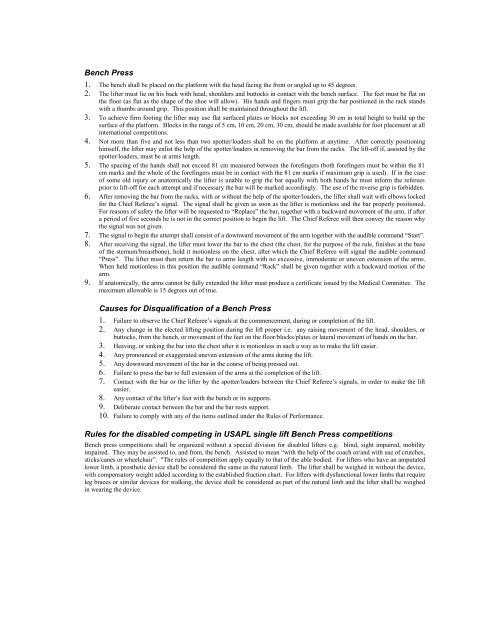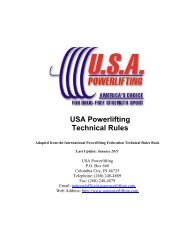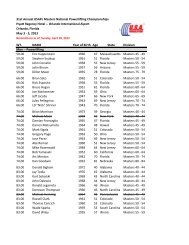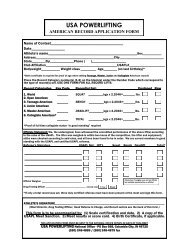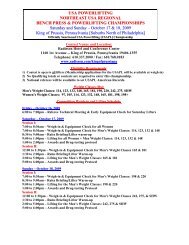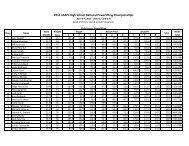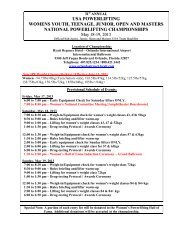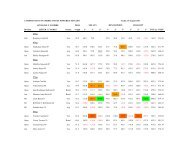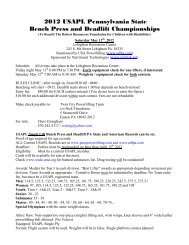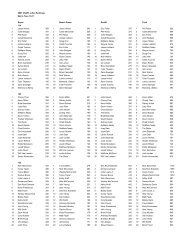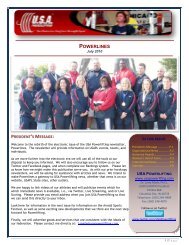Lifter's Handbook - USA Powerlifting
Lifter's Handbook - USA Powerlifting
Lifter's Handbook - USA Powerlifting
Create successful ePaper yourself
Turn your PDF publications into a flip-book with our unique Google optimized e-Paper software.
Bench Press<br />
1. The bench shall be placed on the platform with the head facing the front or angled up to 45 degrees.<br />
2. The lifter must lie on his back with head, shoulders and buttocks in contact with the bench surface. The feet must be flat on<br />
the floor (as flat as the shape of the shoe will allow). His hands and fingers must grip the bar positioned in the rack stands<br />
with a thumbs around grip. This position shall be maintained throughout the lift.<br />
3. To achieve firm footing the lifter may use flat surfaced plates or blocks not exceeding 30 cm in total height to build up the<br />
surface of the platform. Blocks in the range of 5 cm, 10 cm, 20 cm, 30 cm, should be made available for foot placement at all<br />
international competitions.<br />
4. Not more than five and not less than two spotter/loaders shall be on the platform at anytime. After correctly positioning<br />
himself, the lifter may enlist the help of the spotter/loaders in removing the bar from the racks. The lift-off if, assisted by the<br />
spotter/loaders, must be at arms length.<br />
5. The spacing of the hands shall not exceed 81 cm measured between the forefingers (both forefingers must be within the 81<br />
cm marks and the whole of the forefingers must be in contact with the 81 cm marks if maximum grip is used). If in the case<br />
of some old injury or anatomically the lifter is unable to grip the bar equally with both hands he must inform the referees<br />
prior to lift-off for each attempt and if necessary the bar will be marked accordingly. The use of the reverse grip is forbidden.<br />
6. After removing the bar from the racks, with or without the help of the spotter/loaders, the lifter shall wait with elbows locked<br />
for the Chief Referee’s signal. The signal shall be given as soon as the lifter is motionless and the bar properly positioned.<br />
For reasons of safety the lifter will be requested to “Replace” the bar, together with a backward movement of the arm, if after<br />
a period of five seconds he is not in the correct position to begin the lift. The Chief Referee will then convey the reason why<br />
the signal was not given.<br />
7. The signal to begin the attempt shall consist of a downward movement of the arm together with the audible command “Start”.<br />
8. After receiving the signal, the lifter must lower the bar to the chest (the chest, for the purpose of the rule, finishes at the base<br />
of the sternum/breastbone), hold it motionless on the chest, after which the Chief Referee will signal the audible command<br />
“Press”. The lifter must then return the bar to arms length with no excessive, immoderate or uneven extension of the arms.<br />
When held motionless in this position the audible command “Rack” shall be given together with a backward motion of the<br />
arm.<br />
9. If anatomically, the arms cannot be fully extended the lifter must produce a certificate issued by the Medical Committee. The<br />
maximum allowable is 15 degrees out of true.<br />
Causes for Disqualification of a Bench Press<br />
1. Failure to observe the Chief Referee’s signals at the commencement, during or completion of the lift.<br />
2. Any change in the elected lifting position during the lift proper i.e. any raising movement of the head, shoulders, or<br />
buttocks, from the bench, or movement of the feet on the floor/blocks/plates or lateral movement of hands on the bar.<br />
3. Heaving, or sinking the bar into the chest after it is motionless in such a way as to make the lift easier.<br />
4. Any pronounced or exaggerated uneven extension of the arms during the lift.<br />
5. Any downward movement of the bar in the course of being pressed out.<br />
6. Failure to press the bar to full extension of the arms at the completion of the lift.<br />
7. Contact with the bar or the lifter by the spotter/loaders between the Chief Referee’s signals, in order to make the lift<br />
easier.<br />
8. Any contact of the lifter’s feet with the bench or its supports.<br />
9. Deliberate contact between the bar and the bar rests support.<br />
10. Failure to comply with any of the items outlined under the Rules of Performance.<br />
Rules for the disabled competing in <strong>USA</strong>PL single lift Bench Press competitions<br />
Bench press competitions shall be organized without a special division for disabled lifters e.g. blind, sight impaired, mobility<br />
impaired. They may be assisted to, and from, the bench. Assisted to mean “with the help of the coach or/and with use of crutches,<br />
sticks/canes or wheelchair”. "The rules of competition apply equally to that of the able bodied. For lifters who have an amputated<br />
lower limb, a prosthetic device shall be considered the same as the natural limb. The lifter shall be weighed in without the device,<br />
with compensatory weight added according to the established fraction chart. For lifters with dysfunctional lower limbs that require<br />
leg braces or similar devices for walking, the device shall be considered as part of the natural limb and the lifter shall be weighed<br />
in wearing the device.


